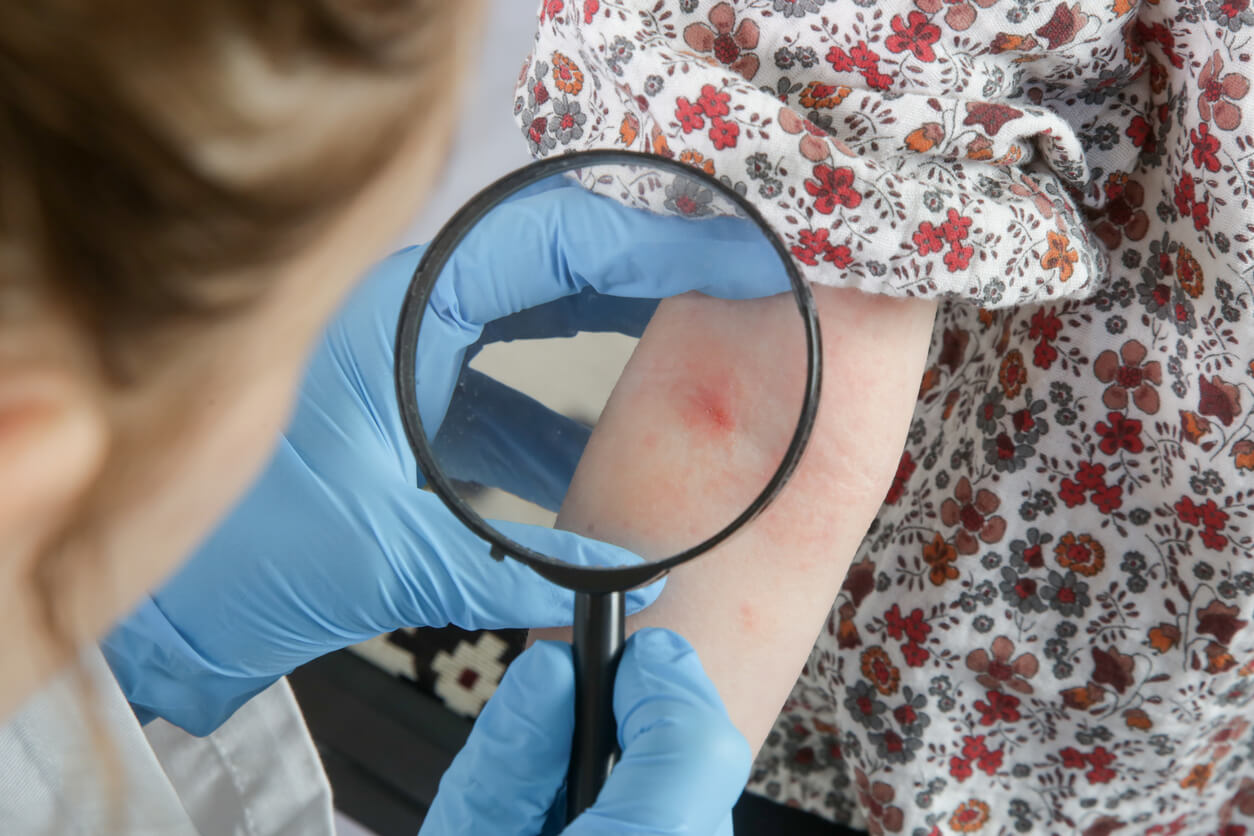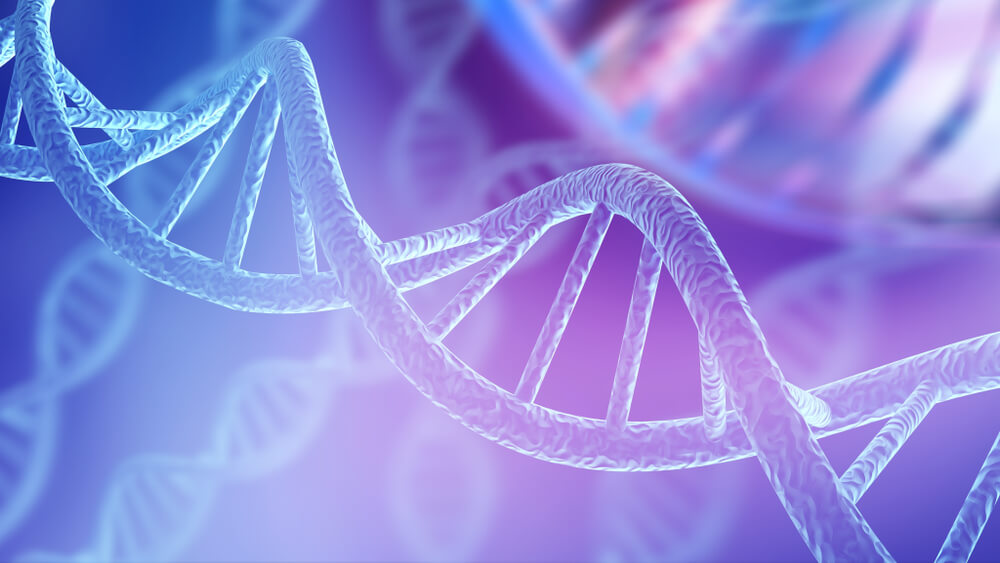Is Atopic Dermatitis Transmitted from Parents to Children?

Atopic dermatitis is a frequent skin condition in children and adults, which leads many to ask themselves the following question: Is atopic dermatitis transmitted from parents to children? Although it’s a disease with a large genetic component, there are multiple factors that can favor its appearance.
Below, we’ll tell you who’s most likely to develop atopic dermatitis. Are you interested in learning more? Keep reading!
What is atopic dermatitis?
Atopic dermatitis is the most common inflammatory disease of the skin in children. It affects between 15 and 30% of children and is characterized by chronic, pruritic, and recurrent skin lesions.
They generally develop during early childhood, between 3 and 6 months of age. More than half of children develop lesions in the first year of life and 90% before the age of 5 years.
Clinical manifestations
The distribution of atopic dermatitis lesions varies with respect to the age of the person who suffers from it.
In infants and newborns (ages 0 to 2 years), it usually manifests as erythematous, pruritic, exudative plaques on the scalp, cheeks, and extensor surfaces of the extremities.
In childhood, this type of lesion progresses to xerosis (dry skin), thickened plaques, papules, and excoriations on the flexing surfaces of the limbs and wrists (2 to 12 years).
In general, the main symptom of atopic disease is dry skin that’s very itchy, which tends to turn into a red rash during flare-ups.

The causes of atopic dermatitis
Many internal and external factors can trigger an outbreak of eczema or dermatitis.
Therefore, the basic understanding of atopic dermatitis is that the inflammation is the result of a misdirected immune system reaction on dry skin with a disrupted skin barrier.
Although there’s a genetic component, atopic dermatitis is a multifactorial disease. In other words, in order for it to develop, other immunological, constitutional, and environmental factors are required. For example, certain climatic conditions, stress, or the presence of microorganisms on the skin or allergens.
Is atopic dermatitis transmitted from parents to children?
As we’ve said, having a relative with atopy is a strong genetic factor when it comes to the development of the disease.
People with the disease often have a family member affected by atopic dermatitis. According to a study by the Journal of Allergy, the chance of inheriting atopic disease is about 75%.
Furthermore, people with atopic dermatitis are more likely to have other atopic conditions such as asthma or allergies.
Genes are what carry the necessary information to make each element of the body. Each person has two copies of the same gene, one from each parent. Therefore, a person is capable of inheriting genes that are mutated from one or both parents, which increases the chances of developing the disease.
The CARD11 gene
There are several genes that could be related to the development of atopic dermatitis and, in some rarer cases, just inheriting a mutation in one of them is enough to suffer from this disease.
The CARD11 gene has the necessary information to make a protein present in white blood cells (defense cells). Mutations in this gene could favor atopic dermatitis as a result of a weak immune system.
Incidentally, a study by Nature Genetics found that just one mutation of a CARD11 gene is enough to develop atopic dermatitis.
The FLG gene
Another gene involved in the development of atopic dermatitis is the one that codes for profilaggrin, which is the precursor of the filaggrin protein. This element plays an essential role in maintaining the skin barrier and in moisturizing the skin.
Between 20 and 30% of those with atopic dermatitis have a mutation in the filaggrin gene. The disease even tends to be more severe in those people who have mutations in both copies of the gene.
The KIF3A gene
The KIF3A gene codes for a protein that’s involved in cell signaling and in the transport of some proteins. Alteration of this DNA component can increase the chances of developing atopic dermatitis.
This is mainly due to the loss of water from the skin surface and the weakening of its natural protective barrier.

Atopic dermatitis is a multifactorial disease
So, is atopic dermatitis transmitted from parents to their children? Well, although a person can inherit certain mutated genes from their parents, they can also acquire some of their own mutations throughout life.
In turn, you can have a mutated gene (a condition that increases the possibility of disease), but it remains inactive until it’s exposed to a certain environmental factor.
Therefore, it’s worth knowing that the chances of manifesting this skin disease may be conditioned by family history. However, this isn’t the only reason why your child may suffer from it.
Atopic dermatitis is a frequent skin condition in children and adults, which leads many to ask themselves the following question: Is atopic dermatitis transmitted from parents to children? Although it’s a disease with a large genetic component, there are multiple factors that can favor its appearance.
Below, we’ll tell you who’s most likely to develop atopic dermatitis. Are you interested in learning more? Keep reading!
What is atopic dermatitis?
Atopic dermatitis is the most common inflammatory disease of the skin in children. It affects between 15 and 30% of children and is characterized by chronic, pruritic, and recurrent skin lesions.
They generally develop during early childhood, between 3 and 6 months of age. More than half of children develop lesions in the first year of life and 90% before the age of 5 years.
Clinical manifestations
The distribution of atopic dermatitis lesions varies with respect to the age of the person who suffers from it.
In infants and newborns (ages 0 to 2 years), it usually manifests as erythematous, pruritic, exudative plaques on the scalp, cheeks, and extensor surfaces of the extremities.
In childhood, this type of lesion progresses to xerosis (dry skin), thickened plaques, papules, and excoriations on the flexing surfaces of the limbs and wrists (2 to 12 years).
In general, the main symptom of atopic disease is dry skin that’s very itchy, which tends to turn into a red rash during flare-ups.

The causes of atopic dermatitis
Many internal and external factors can trigger an outbreak of eczema or dermatitis.
Therefore, the basic understanding of atopic dermatitis is that the inflammation is the result of a misdirected immune system reaction on dry skin with a disrupted skin barrier.
Although there’s a genetic component, atopic dermatitis is a multifactorial disease. In other words, in order for it to develop, other immunological, constitutional, and environmental factors are required. For example, certain climatic conditions, stress, or the presence of microorganisms on the skin or allergens.
Is atopic dermatitis transmitted from parents to children?
As we’ve said, having a relative with atopy is a strong genetic factor when it comes to the development of the disease.
People with the disease often have a family member affected by atopic dermatitis. According to a study by the Journal of Allergy, the chance of inheriting atopic disease is about 75%.
Furthermore, people with atopic dermatitis are more likely to have other atopic conditions such as asthma or allergies.
Genes are what carry the necessary information to make each element of the body. Each person has two copies of the same gene, one from each parent. Therefore, a person is capable of inheriting genes that are mutated from one or both parents, which increases the chances of developing the disease.
The CARD11 gene
There are several genes that could be related to the development of atopic dermatitis and, in some rarer cases, just inheriting a mutation in one of them is enough to suffer from this disease.
The CARD11 gene has the necessary information to make a protein present in white blood cells (defense cells). Mutations in this gene could favor atopic dermatitis as a result of a weak immune system.
Incidentally, a study by Nature Genetics found that just one mutation of a CARD11 gene is enough to develop atopic dermatitis.
The FLG gene
Another gene involved in the development of atopic dermatitis is the one that codes for profilaggrin, which is the precursor of the filaggrin protein. This element plays an essential role in maintaining the skin barrier and in moisturizing the skin.
Between 20 and 30% of those with atopic dermatitis have a mutation in the filaggrin gene. The disease even tends to be more severe in those people who have mutations in both copies of the gene.
The KIF3A gene
The KIF3A gene codes for a protein that’s involved in cell signaling and in the transport of some proteins. Alteration of this DNA component can increase the chances of developing atopic dermatitis.
This is mainly due to the loss of water from the skin surface and the weakening of its natural protective barrier.

Atopic dermatitis is a multifactorial disease
So, is atopic dermatitis transmitted from parents to their children? Well, although a person can inherit certain mutated genes from their parents, they can also acquire some of their own mutations throughout life.
In turn, you can have a mutated gene (a condition that increases the possibility of disease), but it remains inactive until it’s exposed to a certain environmental factor.
Therefore, it’s worth knowing that the chances of manifesting this skin disease may be conditioned by family history. However, this isn’t the only reason why your child may suffer from it.
All cited sources were thoroughly reviewed by our team to ensure their quality, reliability, currency, and validity. The bibliography of this article was considered reliable and of academic or scientific accuracy.
- Kay J, Gawkrodger DJ, Mortimer MJ, Jaron AG. The prevalence of childhood atopic eczema in a general population. J Am Acad Dermatol. 1994 Jan;30(1):35-9. doi: 10.1016/s0190-9622(94)70004-4. PMID: 8277028.
- Chiesa Fuxench ZC. Atopic Dermatitis: Disease Background and Risk Factors. Adv Exp Med Biol. 2017;1027:11-19. doi: 10.1007/978-3-319-64804-0_2. PMID: 29063427.
- Elmose, Camilla, and Simon Francis Thomsen. “Twin Studies of Atopic Dermatitis: Interpretations and Applications in the Filaggrin Era.” Journal of allergy vol. 2015 (2015): 902359. doi:10.1155/2015/902359
- Ma CA, Stinson JR, Zhang Y, Abbott JK, Weinreich MA, Hauk PJ, Reynolds PR, Lyons JJ, Nelson CG, Ruffo E, Dorjbal B, Glauzy S, Yamakawa N, Arjunaraja S, Voss K, Stoddard J, Niemela J, Zhang Y, Rosenzweig SD, McElwee JJ, DiMaggio T, Matthews HF, Jones N, Stone KD, Palma A, Oleastro M, Prieto E, Bernasconi AR, Dubra G, Danielian S, Zaiat J, Marti MA, Kim B, Cooper MA, Romberg N, Meffre E, Gelfand EW, Snow AL, Milner JD. Germline hypomorphic CARD11 mutations in severe atopic disease. Nat Genet. 2017 Aug;49(8):1192-1201. doi: 10.1038/ng.3898. Epub 2017 Jun 19. Erratum in: Nat Genet. 2017 Oct 27;49(11):1661. PMID: 28628108; PMCID: PMC5664152.
This text is provided for informational purposes only and does not replace consultation with a professional. If in doubt, consult your specialist.








